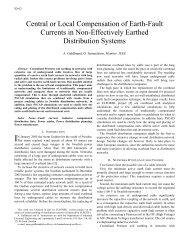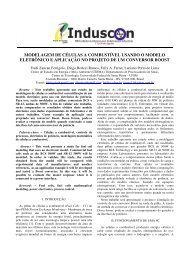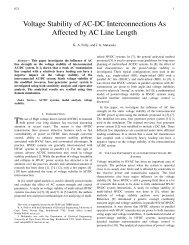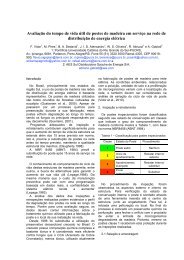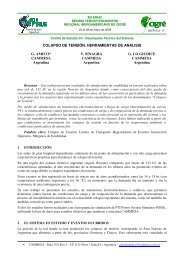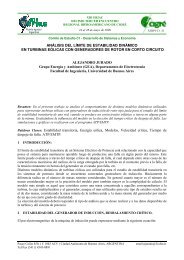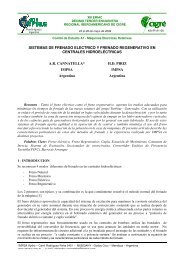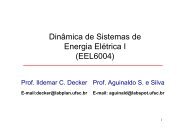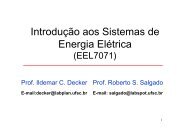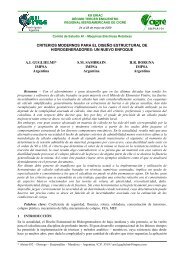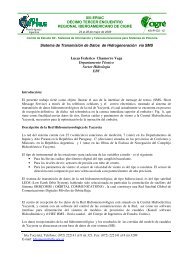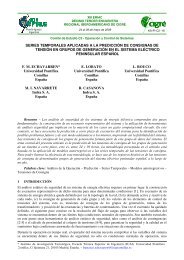Earth Return Path Impedances of Underground Cables for ... - LabPlan
Earth Return Path Impedances of Underground Cables for ... - LabPlan
Earth Return Path Impedances of Underground Cables for ... - LabPlan
You also want an ePaper? Increase the reach of your titles
YUMPU automatically turns print PDFs into web optimized ePapers that Google loves.
Equations (4) and (7) differ in two points. First (4) includes<br />
the Bessel functions, which seem to be no serious problem as<br />
they can be evaluated easily using standard library functions.<br />
The key difference though is the fact that the exponential<br />
function in the infinite integral in (6) is complex, while in (7),<br />
it is real. As a result the real and imaginary parts <strong>of</strong> the infinite<br />
integral <strong>of</strong> (7) are monotonic and non-oscillatory functions [1]<br />
and can be calculated by infinite series, which converge<br />
rapidly [5].<br />
In the approach <strong>of</strong> Wedepohl [3] the infinite integral <strong>of</strong> (5)<br />
is divided in parts, each <strong>of</strong> which is approximated using<br />
infinite series. Simplified expressions <strong>of</strong> the general <strong>for</strong>mulas<br />
are also proposed <strong>for</strong> low frequencies and usual cable<br />
configurations.<br />
In the supporting routines CABLE<br />
CONSTANTS/PARAMETERS <strong>of</strong> EMTP, the earth return<br />
impedances <strong>of</strong> cables are calculated using Carson’s <strong>for</strong>mula<br />
(7) <strong>for</strong> overhead conductors, which is evaluated by infinite<br />
series. This approximation is based on the assumption that<br />
a >> m . This is a highly uncertain approximation, which is<br />
obviously false <strong>for</strong> high frequencies and low earth<br />
resistivities. This approximation is used in [5] together with<br />
the approach <strong>of</strong> Wedepohl [3] <strong>for</strong> a single case <strong>of</strong> two<br />
underground conductors. The results are compared with those<br />
obtained by the numerical integration <strong>of</strong> (5), using Romberg<br />
extrapolation [14]. The approximation <strong>of</strong> EMTP shows<br />
significant differences <strong>for</strong> frequencies greater than 10 kHz,<br />
while Wedepohl’s approach is accurate enough at least up to<br />
100 kHz. In the same reference, numerical efficiency<br />
problems concerning the application <strong>of</strong> the integration method<br />
are reported.<br />
Finally direct numerical integration is also used in [7].<br />
Several integration methods, such as Simpson rule and<br />
Romberg rule [14] are tried. Problems concerning the<br />
numerical efficiency <strong>of</strong> all methods are reported, leading to<br />
the adaptation <strong>of</strong> artificial intelligence techniques <strong>for</strong> the<br />
evaluation <strong>of</strong> the infinite integrals.<br />
All above approaches either use approximations, which are<br />
valid only within certain limits, or suffer from numerical<br />
efficiency, which prohibits their generalized application.<br />
There<strong>for</strong>e the problem <strong>of</strong> finding an efficient and accurate<br />
method <strong>for</strong> the numerical evaluation <strong>of</strong> the infinite integral in<br />
(6) is still <strong>of</strong> research interest.<br />
Direct numerical integration <strong>of</strong> the infinite integral is the<br />
method used in this contribution <strong>for</strong> the evaluation <strong>of</strong> (6).<br />
Instead <strong>of</strong> using the previously mentioned integration<br />
methods,<br />
a novel integration technique is used, based on combinations<br />
<strong>of</strong> integration methods. More specifically, the Gauss-<br />
Legendre method, a highly accurate numerical integration<br />
method applicable in finite intervals <strong>of</strong> functions is combined<br />
with two other methods: the Gauss-Laguerre method, which is<br />
best suited <strong>for</strong> infinite integrals and the Lobatto rule, a very<br />
efficient method <strong>for</strong> oscillative functions [14]. The selective<br />
implementation <strong>of</strong> the different integration methods in the<br />
intervals between the roots <strong>of</strong><br />
cos( ax)<br />
, <strong>for</strong> both the real and<br />
the imaginary part <strong>of</strong> J , leads to a quick and very efficient<br />
integration scheme <strong>for</strong> the evaluation <strong>of</strong> (6).<br />
m<br />
IV. THE FINITE ELEMENT APPROACH<br />
The problem <strong>of</strong> the calculation <strong>of</strong> the cable series<br />
impedance matrix in (1) could be greatly simplified, assuming<br />
that the per unit length voltage drop V<br />
i<br />
on every conductor is<br />
known <strong>for</strong> a specific current excitation. The mutual complex<br />
series impedance per unit length Z ′ between conductor i and<br />
another conductor j carrying current I<br />
j<br />
, where all other<br />
conductors are <strong>for</strong>ced to carry zero currents, is then given by:<br />
ij<br />
Vi<br />
Zij<br />
′ = ( i, j = 1, 2, …, n)<br />
(8)<br />
I<br />
j<br />
The self impedance <strong>of</strong> a conductor may also be calculated<br />
from (8), by setting i = j. In such a case, the following<br />
procedure may be used <strong>for</strong> the calculation <strong>of</strong> the cable series<br />
impedance matrix [13]:<br />
• A sinusoidal current excitation <strong>of</strong> arbitrary magnitude is<br />
applied sequentially to each cable conductor, while the<br />
remaining conductors are <strong>for</strong>ced to carry zero currents.<br />
The corresponding voltages are recorded.<br />
• Using (8), the self and mutual impedances <strong>of</strong> the j cable<br />
conductor may be calculated. This procedure is repeated n<br />
times, in order to calculate the impedances <strong>of</strong> n<br />
conductors.<br />
There<strong>for</strong>e, the problem is reduced to that <strong>of</strong> calculating the<br />
actual per unit length voltage drops, when a current excitation<br />
is applied to the conductors. This may be achieved by a<br />
suitable Finite Element Method (FEM) <strong>for</strong>mulation <strong>of</strong> the<br />
electromagnetic diffusion equation.<br />
An underground power cable arrangement, consisting <strong>of</strong><br />
n parallel conductors, is assumed to be long enough to ignore<br />
end effects. Furthermore, if the current density vector is<br />
supposed to be in the z direction, the problem becomes twodimensional<br />
and it is confined in the x-y plane, in which the<br />
conductors’ cross sections lie. The above two-dimensional<br />
diffusion problem is described by the system <strong>of</strong> equations<br />
[15],<br />
where<br />
2 2<br />
1 ⎡∂<br />
Az<br />
∂ A ⎤<br />
z<br />
⎢ + j A<br />
2 2 ⎥− ωσ<br />
z<br />
+ J<br />
µµ<br />
0 r ⎣∂x<br />
∂y<br />
⎦<br />
z sz z<br />
sz<br />
= 0 (9)<br />
− jωσ<br />
A + J = J<br />
(10)<br />
∫∫ JdS<br />
z<br />
= Ii<br />
, i=1, 2, ... , n (11)<br />
Si<br />
A<br />
z<br />
is the z direction component <strong>of</strong> the magnetic vector<br />
potential (MVP).<br />
In (10) the total current density<br />
two components,<br />
J z<br />
is decomposed in



